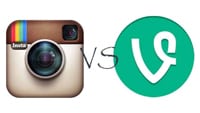Instagram set off a social-video cage match when it launched Instagram Video, planting it squarely up against Vine. It lets users shoot and post video with the same immediacy that has made Instagram photos so popular and prolific.
 In its first six weeks, users have posted over 800,000 videos with the hashtag #Instavideo. Twice as many of the Top 100 brands are using Instagram video than Vine (14 brands vs. 7) as marketers test-drive their options: Instagram? Vine? (Both?)
In its first six weeks, users have posted over 800,000 videos with the hashtag #Instavideo. Twice as many of the Top 100 brands are using Instagram video than Vine (14 brands vs. 7) as marketers test-drive their options: Instagram? Vine? (Both?)
Social video is a great avenue for brands eager to beef up their content, and increase contacts.
Alas, both Vine and Instagram Video have an annoying limitation that hamstrings them for marketing: You can’t share one video between the two platforms. You have to shoot and post within each app itself. So there’s no way to shoot—edit—perfect—distribute video . . . the way brands have always worked with online video (and broadcast ads).
The only option: shoot brand new video in each platform. That’s double the workload, and a challenge for consistent messaging.
So brands may find themselves choosing between Instagram Video and Vine. And how will they decide? By the audience that matters most.
Here are five questions each brand should ask to sort it out:
1. Which audience matters more, Vine or Instagram?
Instagram has been around longer than Vine and has a larger user base: 100 million monthly active users. Most brands have a larger presence on Instagram. For example, Starbucks has over 1.4 million followers on Instagram, but only 99,858 on Vine. Brands still have a long way to go to build up a Vine follower base.
2. Which audience matters more, Facebook or Twitter?
Instagram is owned by Facebook; Vine is owned by Twitter. Each video platform is king to its respective parent platform. Instagram plays within the Facebook News Feed and takes up a lot of real estate, while Vines only appear in FB as a link. Vines take the top spot on Twitter, playing within the feed, while Instagram videos get simply a link. In its first six months, Vine videos have surpassed Instagram photo shares on Twitter—making Vine the go-to for reaching Twitter followers.
The bigger your audience on Facebook or Twitter, the more distribution your videos will receive. Do your advocates already engage with the brand more on one platform over the other? Sharing your videos could lead to a much broader reach than your owned audience alone.
3. How much do I have to say?
Instagram allows for 15 seconds of video—long enough for a TV spot—while Vine only allows for six seconds. Both platforms have a minimum of three seconds, and both allow you to do less than the maximum.
Instagram allows for both photos and videos. Vine is only for video.
4. What other platforms do I want to distribute to?
Instagram supports Foursquare, flickr, tumblr and more. Vine supports Facebook and Twitter.
5. Can I do both?
If your brand strategy incorporates both Instagram and Vine, you can build separate audiences and target different videos to each one.
This examination is especially important for mid-size and small brands. Neither Vine nor Instagram Video have a native advertising platform. So unless yours is a large brand that happens to have a follower base on either platform, it will be tough to get distribution of your video content.
There are a couple of clumsy workarounds for promoting video via Twitter (promoted tweets) and Facebook (sponsored link posts) but for the most part, all but the big brands will have more steps to manage—and more motivation to choose thoughtfully.
Jaime Hoerbelt is social media director at digital agency Tenthwave. She can be reached at Jaime.hoerbelt@tenthwave.com.



